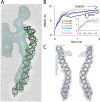Collective variable approaches for single molecule flexible fitting and enhanced sampling
- PMID: 24446720
- PMCID: PMC3983124
- DOI: 10.1021/cr4005988
Collective variable approaches for single molecule flexible fitting and enhanced sampling
Figures






Similar articles
-
A quantitative model of thermal stabilization and destabilization of proteins by ligands.Biophys J. 2008 Oct;95(7):3222-31. doi: 10.1529/biophysj.108.134973. Epub 2008 Jul 3. Biophys J. 2008. PMID: 18599640 Free PMC article.
-
A novel two-site binding equation presented in terms of the total ligand concentration.FEBS Lett. 1996 Sep 2;392(3):245-9. doi: 10.1016/0014-5793(96)00818-6. FEBS Lett. 1996. PMID: 8774854
-
Rational design of affinity peptide ligand by flexible docking simulation.J Chromatogr A. 2007 Mar 30;1146(1):41-50. doi: 10.1016/j.chroma.2007.01.130. Epub 2007 Feb 4. J Chromatogr A. 2007. PMID: 17298835
-
Computational approaches to molecular recognition.Curr Opin Chem Biol. 1997 Dec;1(4):449-57. doi: 10.1016/s1367-5931(97)80038-5. Curr Opin Chem Biol. 1997. PMID: 9667895 Review.
-
New approaches for computing ligand-receptor binding kinetics.Curr Opin Struct Biol. 2018 Apr;49:1-10. doi: 10.1016/j.sbi.2017.10.001. Epub 2017 Nov 11. Curr Opin Struct Biol. 2018. PMID: 29132080 Review.
Cited by
-
All-Atom Structural Models of the Transmembrane Domains of Insulin and Type 1 Insulin-Like Growth Factor Receptors.Front Endocrinol (Lausanne). 2016 Jun 20;7:68. doi: 10.3389/fendo.2016.00068. eCollection 2016. Front Endocrinol (Lausanne). 2016. PMID: 27379020 Free PMC article.
-
Internal force corrections with machine learning for quantum mechanics/molecular mechanics simulations.J Chem Phys. 2017 Oct 28;147(16):161732. doi: 10.1063/1.5006882. J Chem Phys. 2017. PMID: 29096448 Free PMC article.
-
Theoretical and computational studies of peptides and receptors of the insulin family.Membranes (Basel). 2015 Feb 11;5(1):48-83. doi: 10.3390/membranes5010048. Membranes (Basel). 2015. PMID: 25680077 Free PMC article. Review.
-
Structural and computational studies of HIV-1 RNA.RNA Biol. 2024 Jan;21(1):1-32. doi: 10.1080/15476286.2023.2289709. Epub 2023 Dec 15. RNA Biol. 2024. PMID: 38100535 Free PMC article. Review.
References
Publication types
MeSH terms
Substances
Grants and funding
LinkOut - more resources
Full Text Sources
Other Literature Sources

